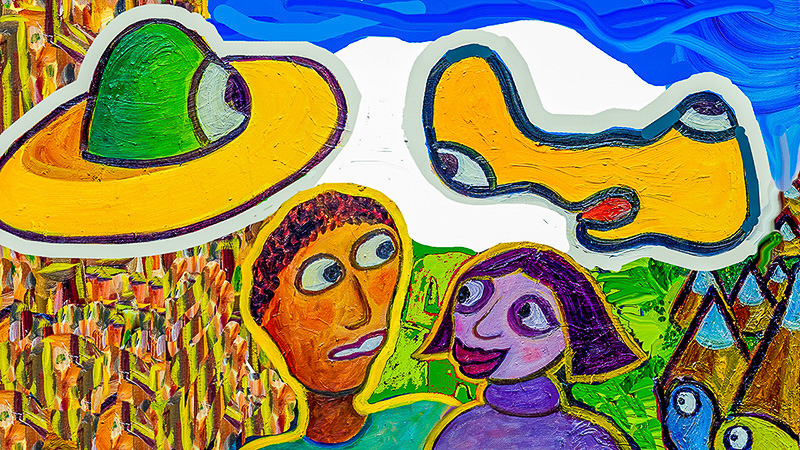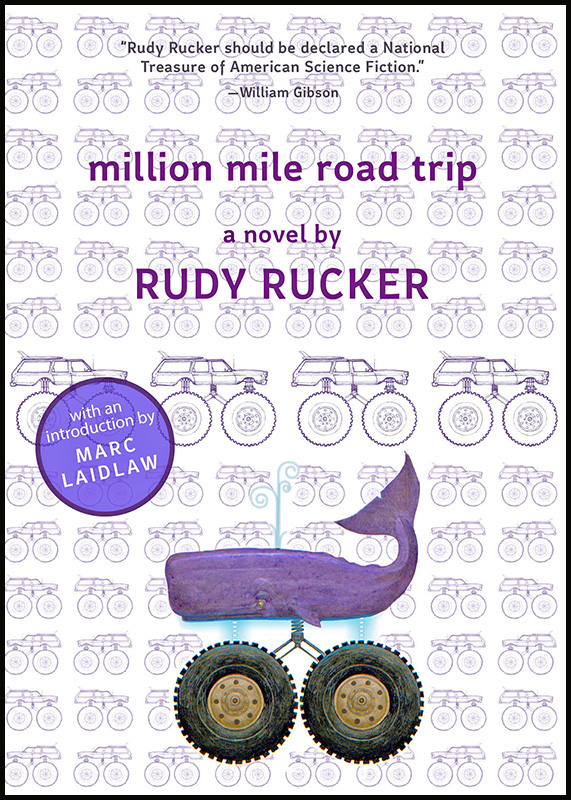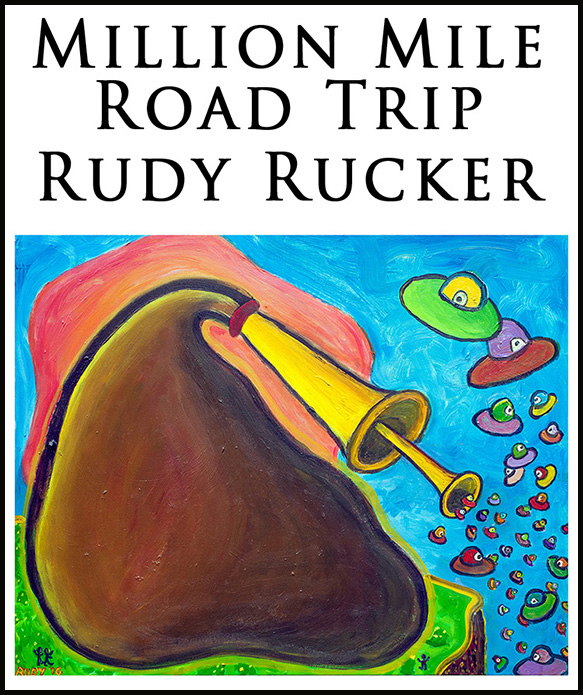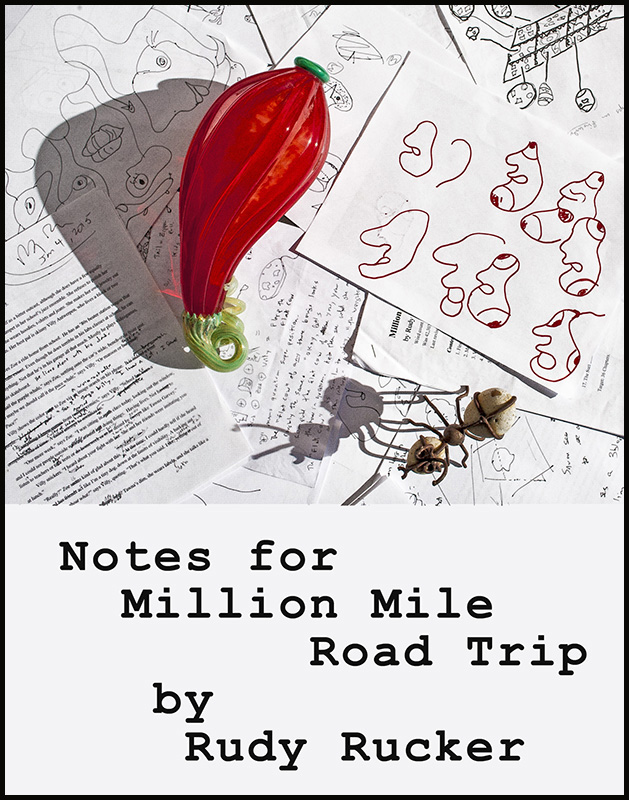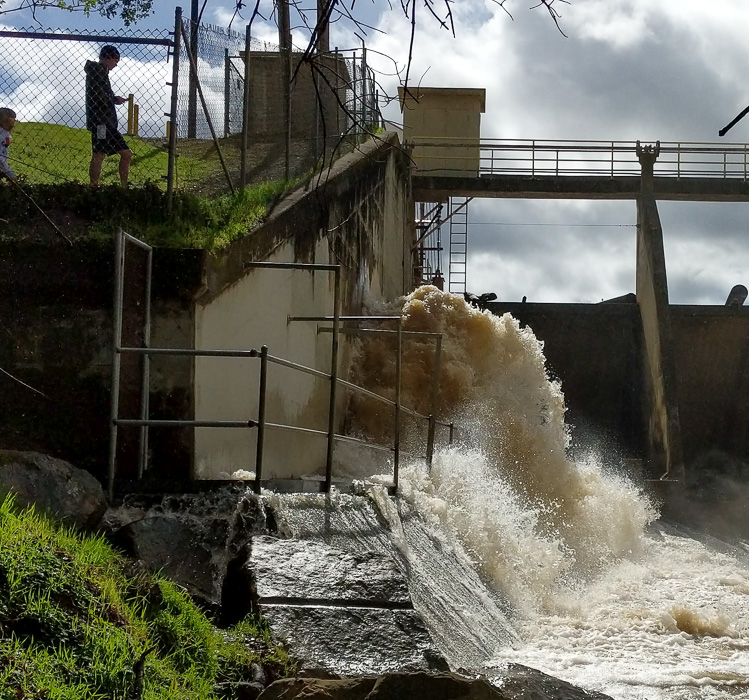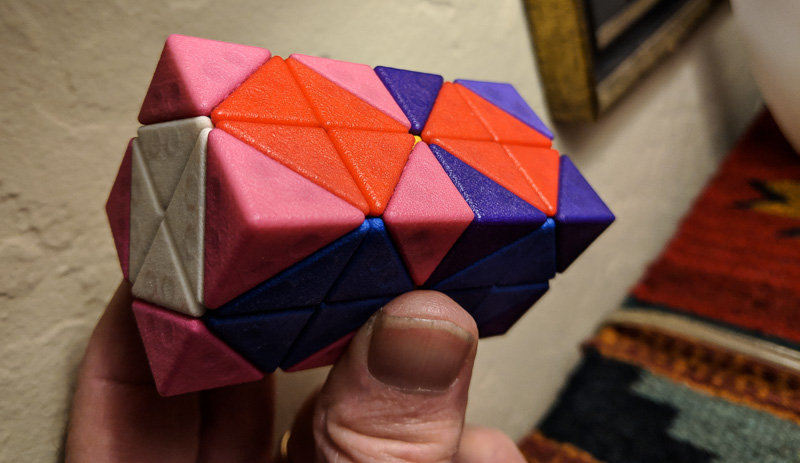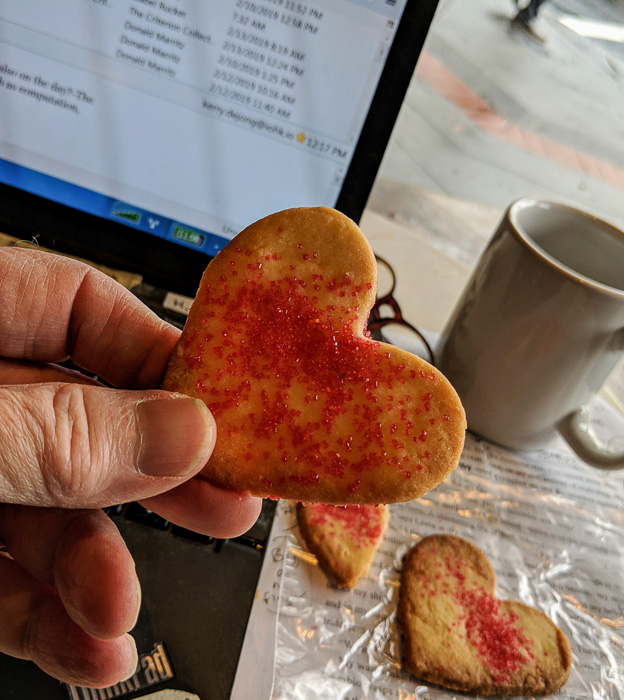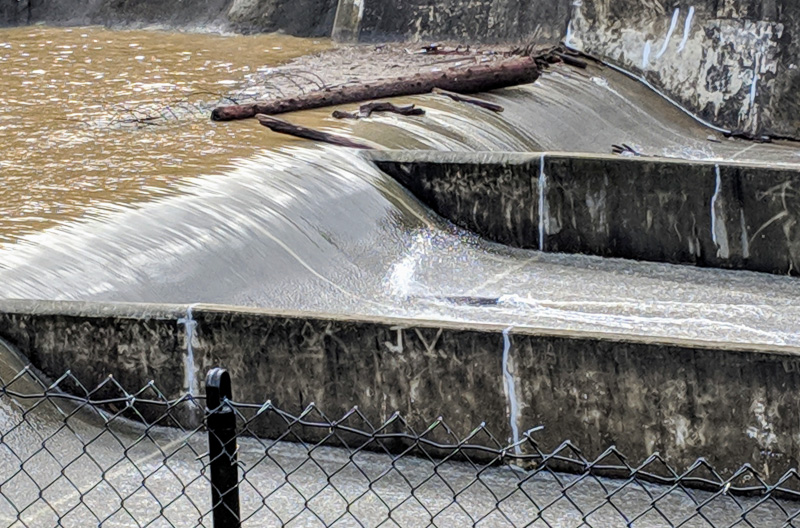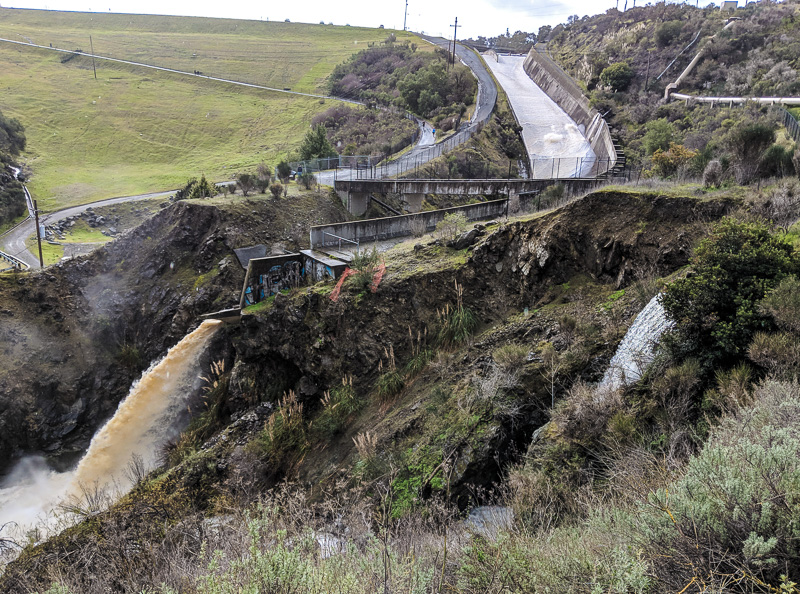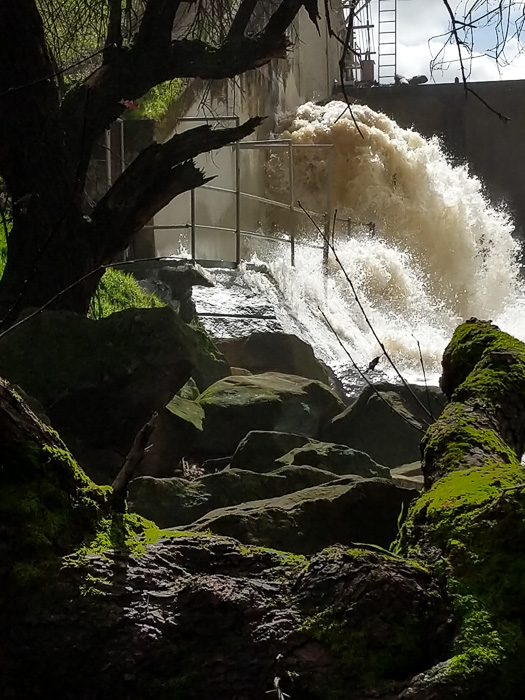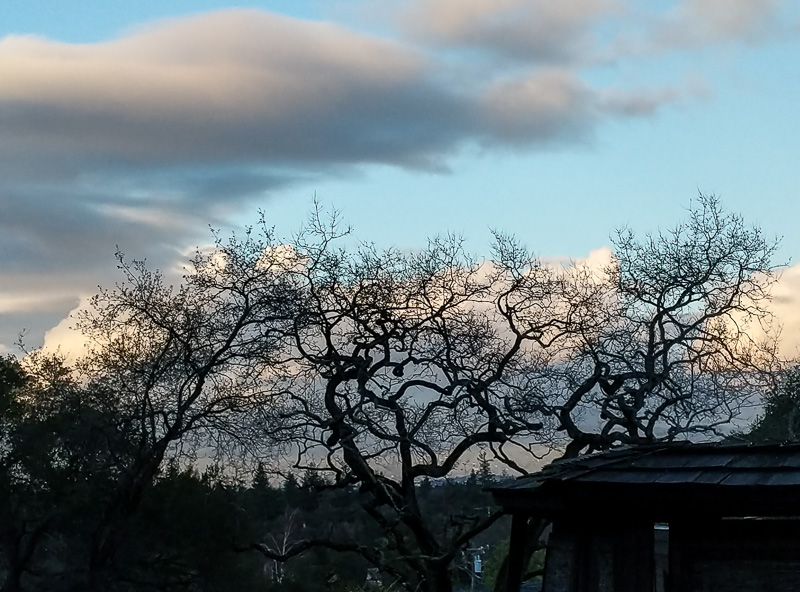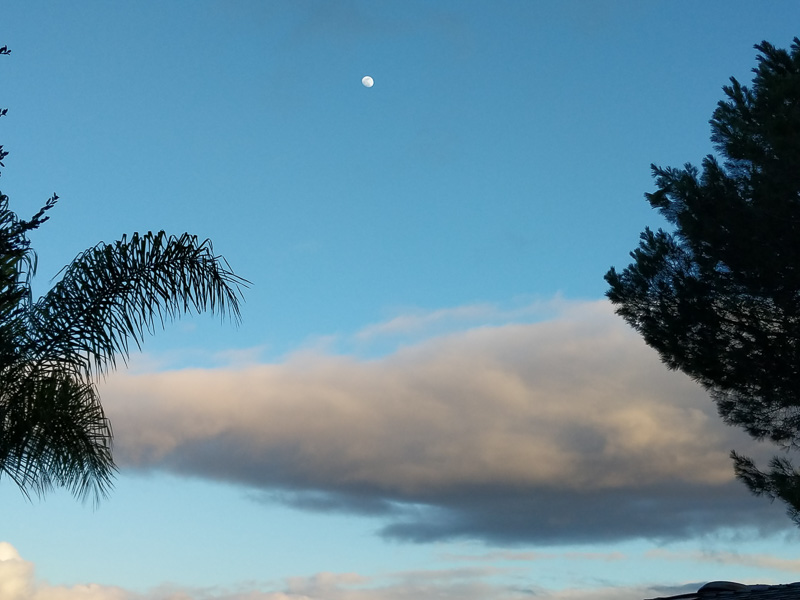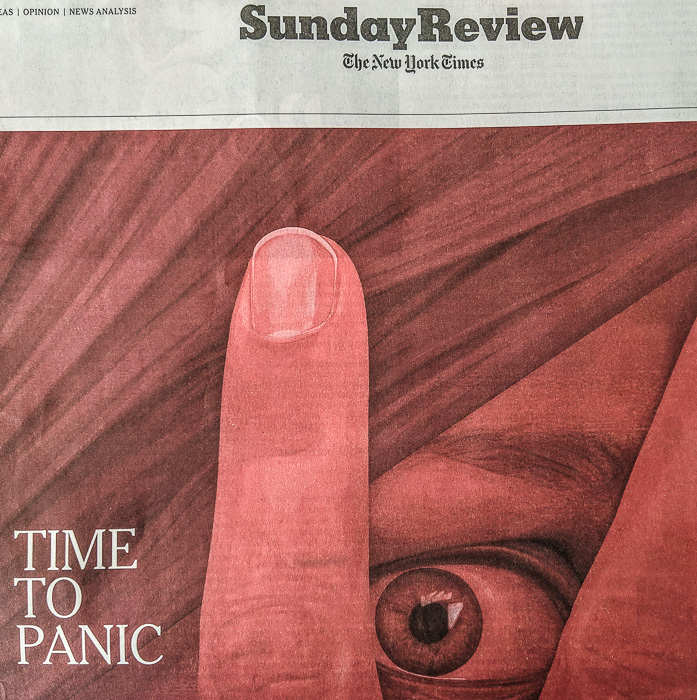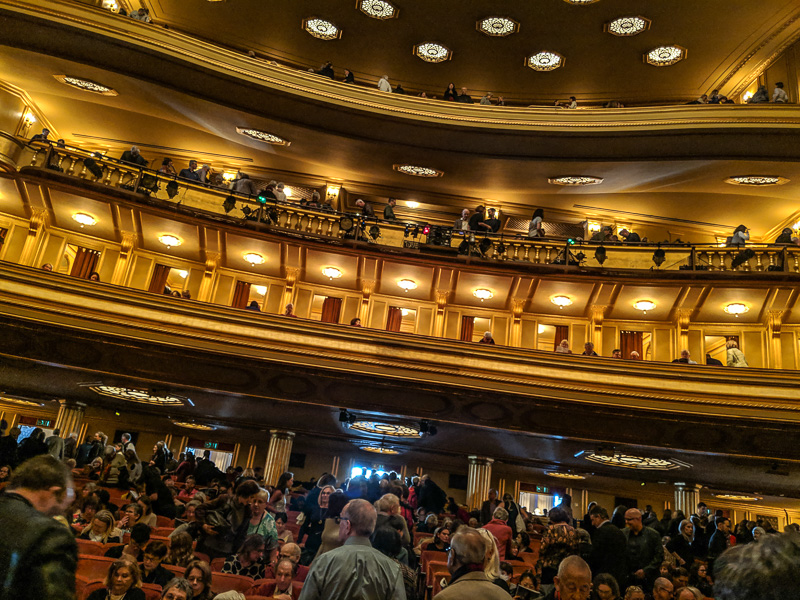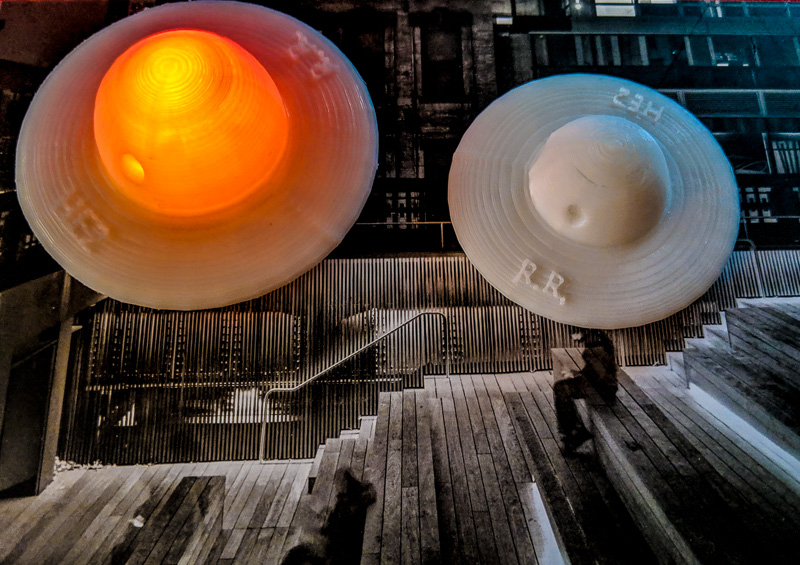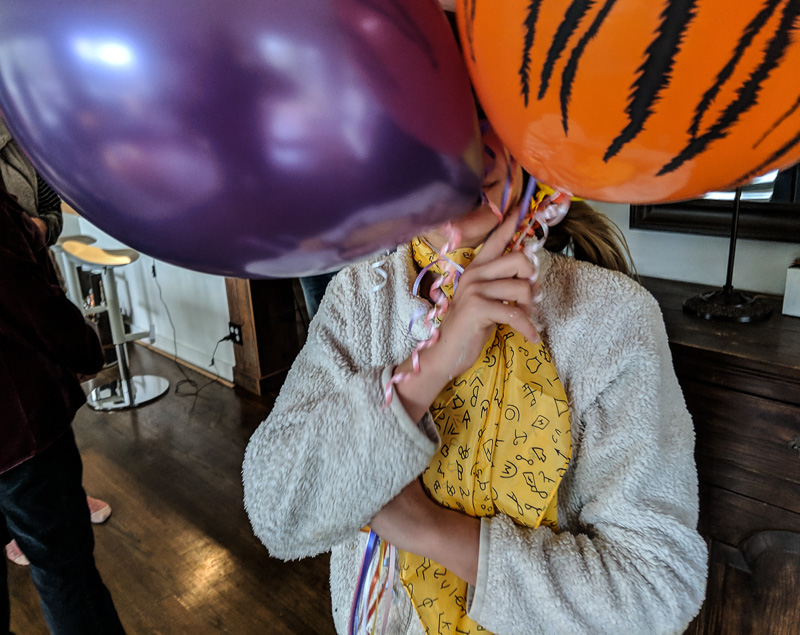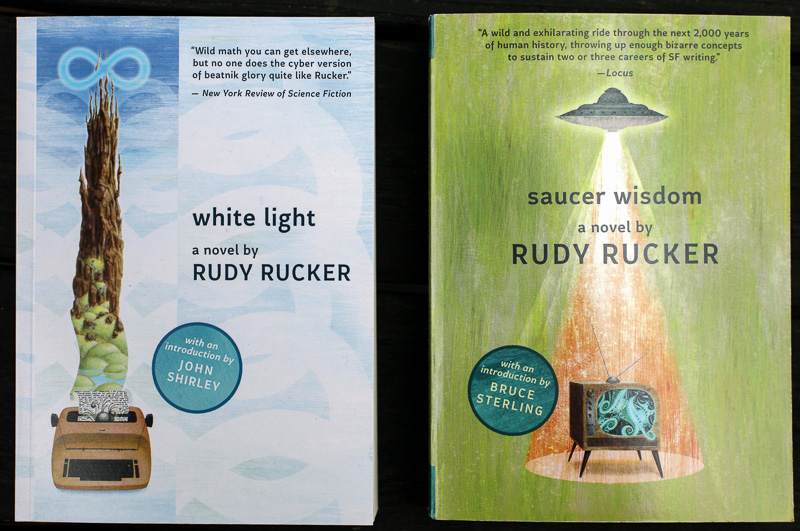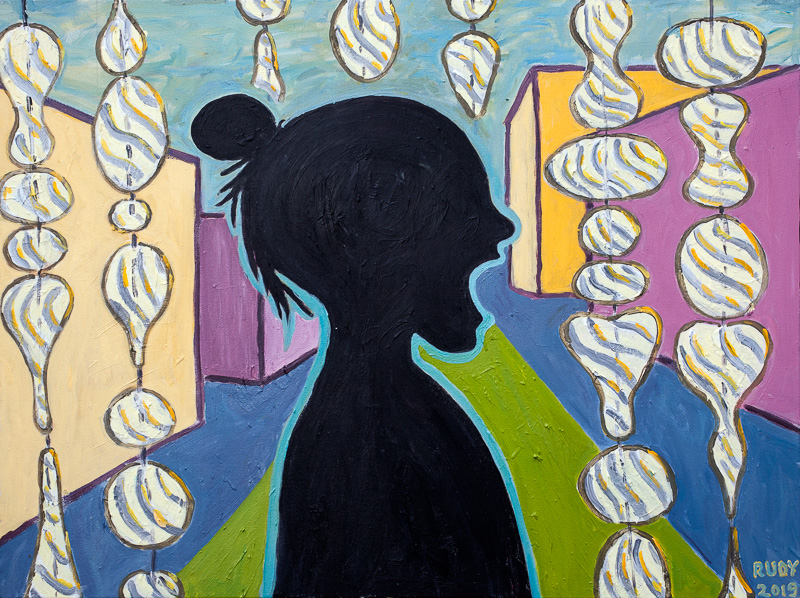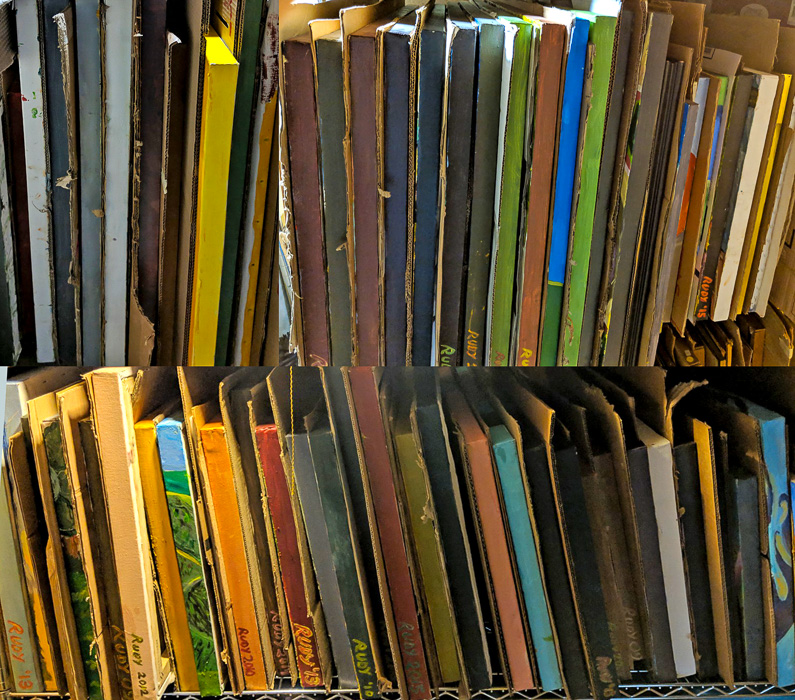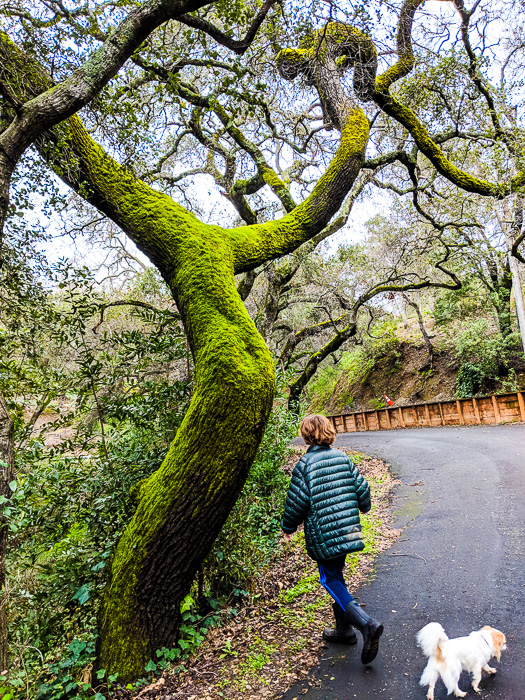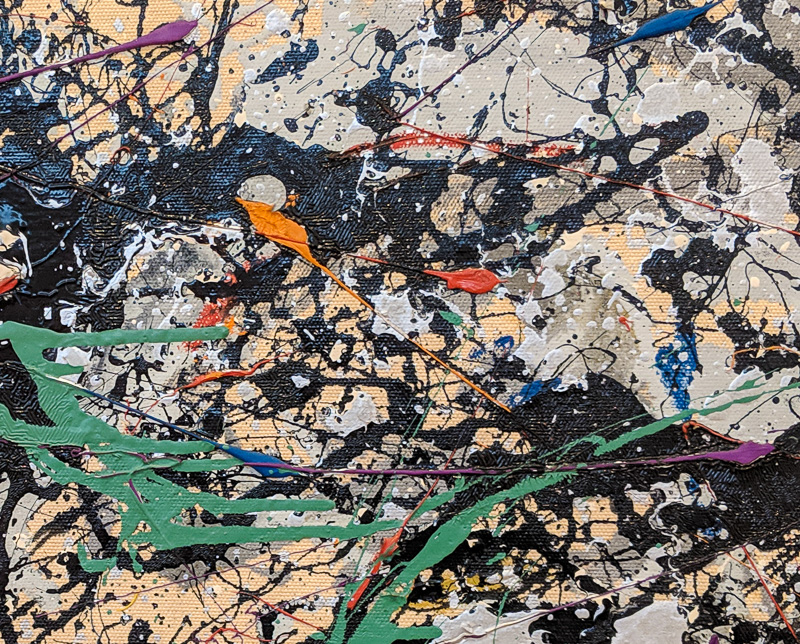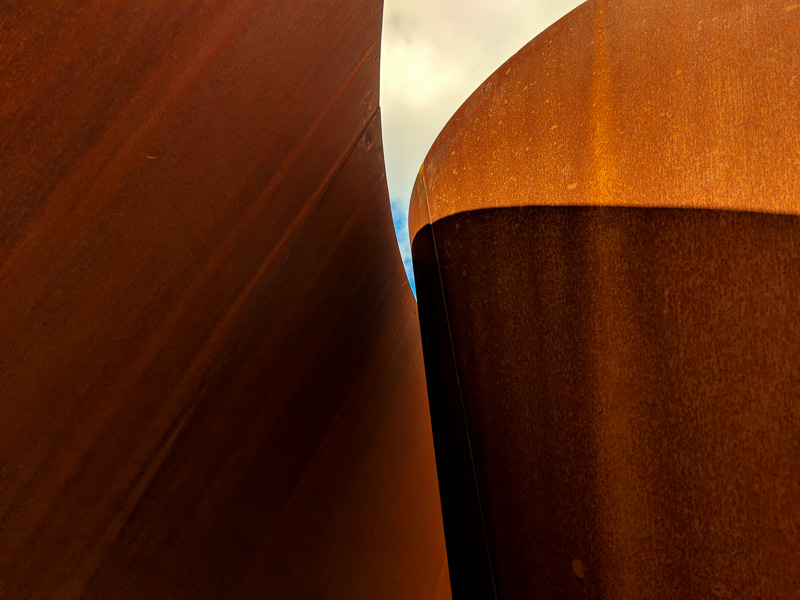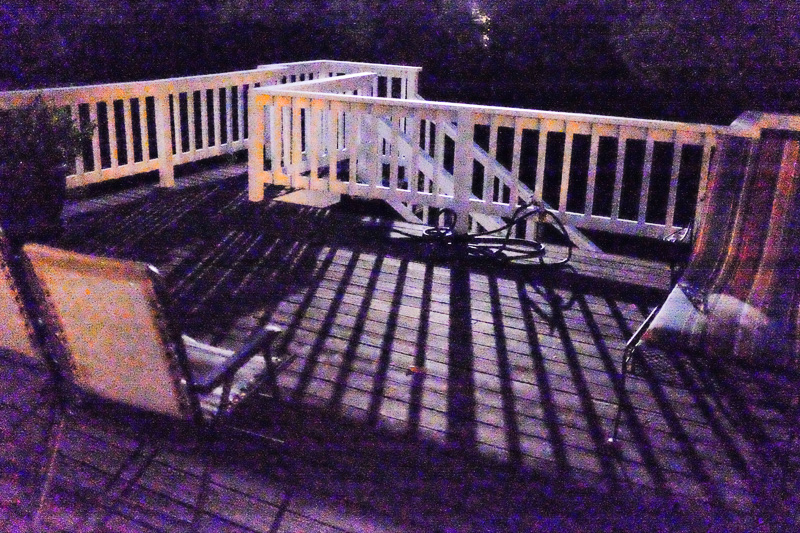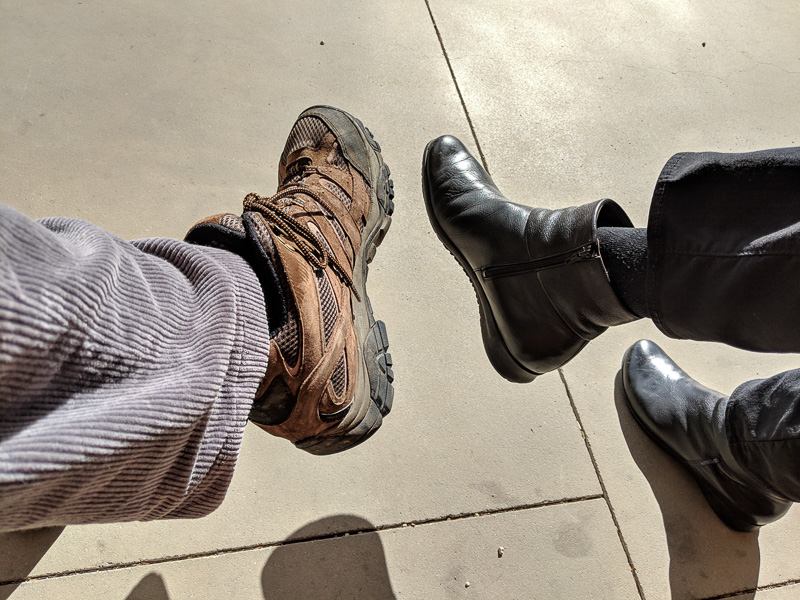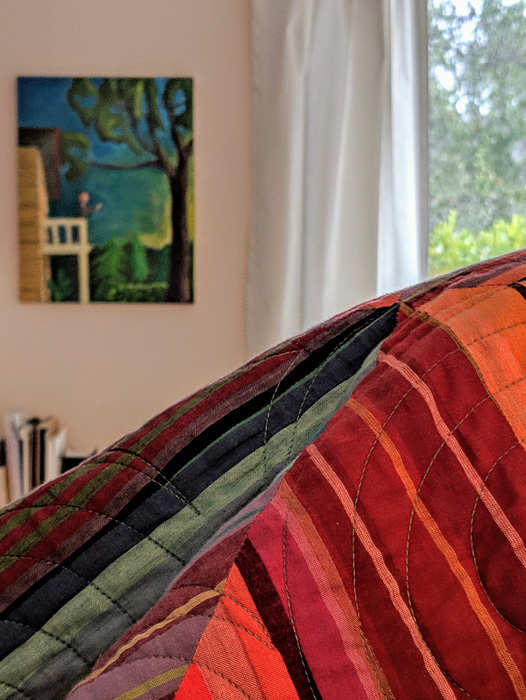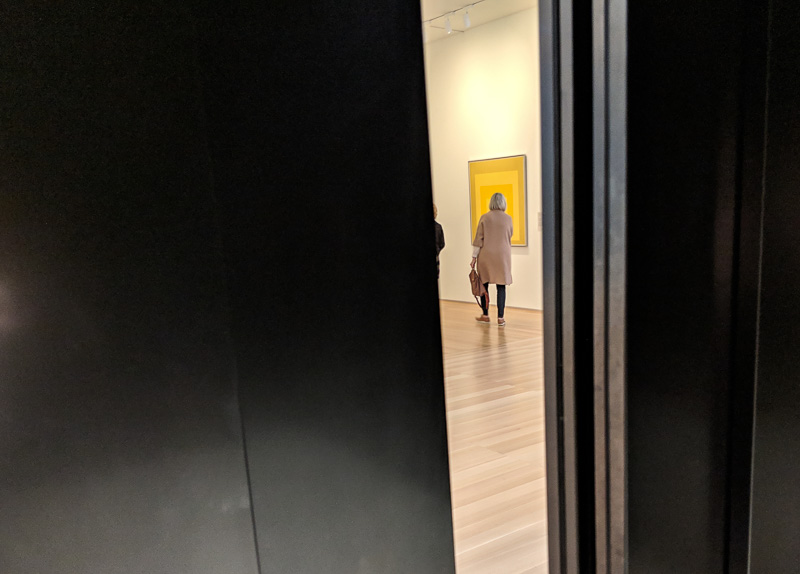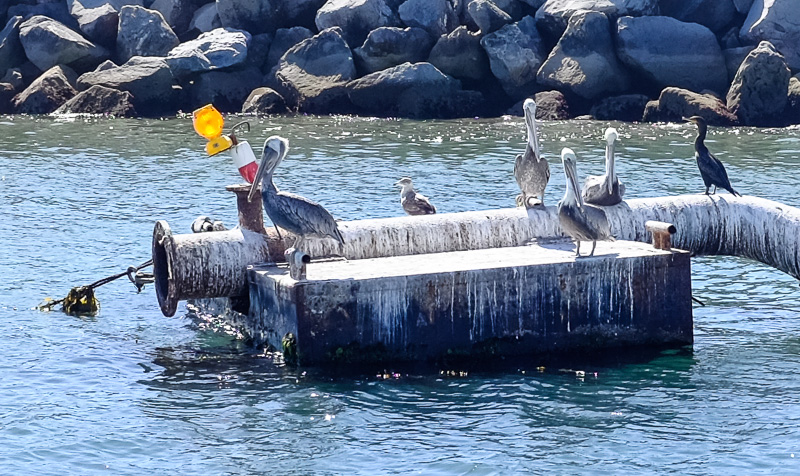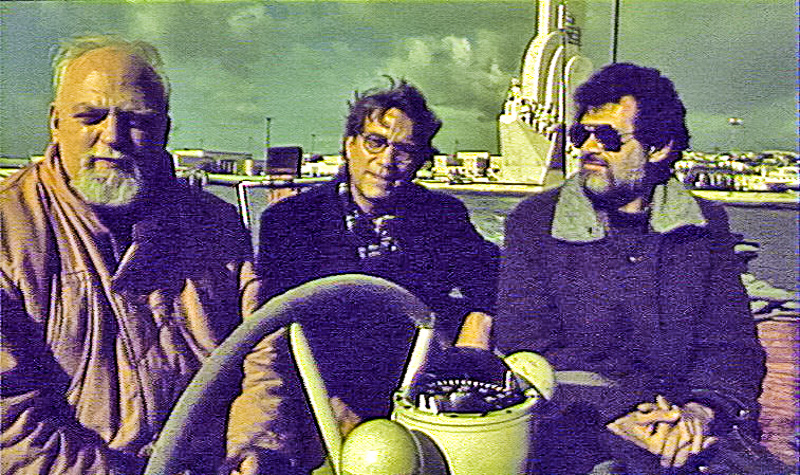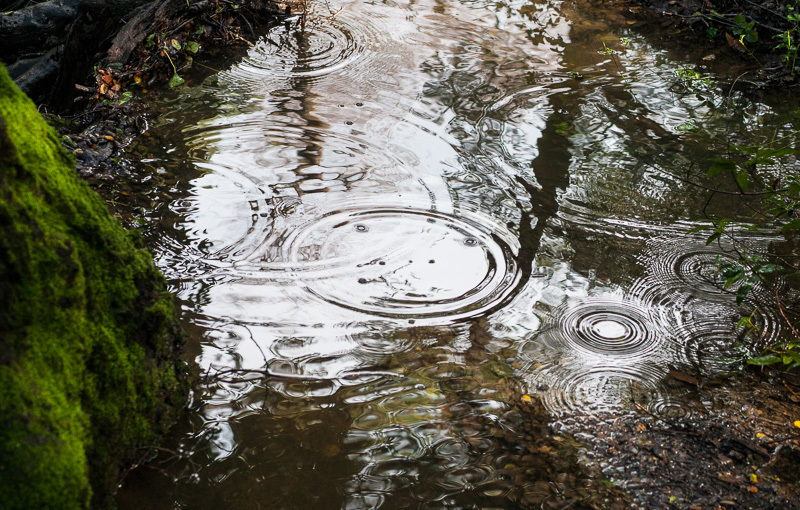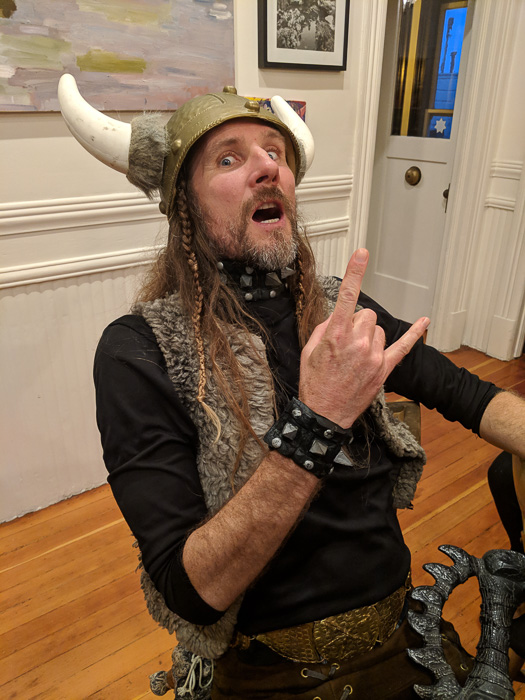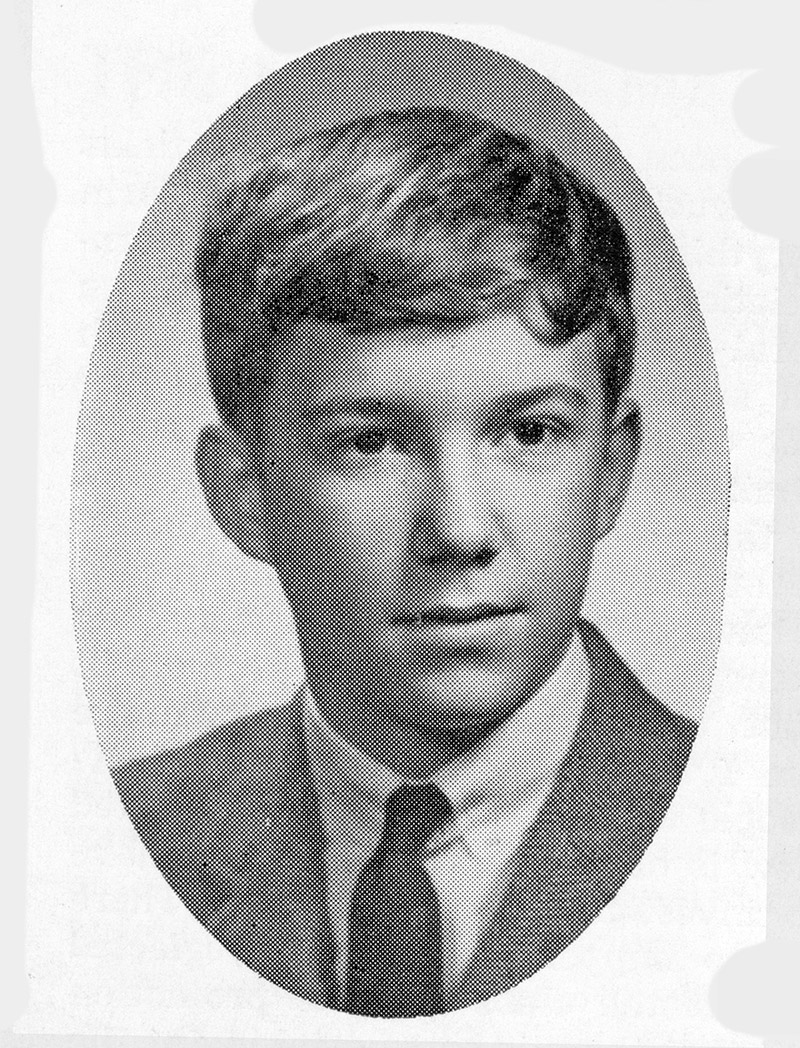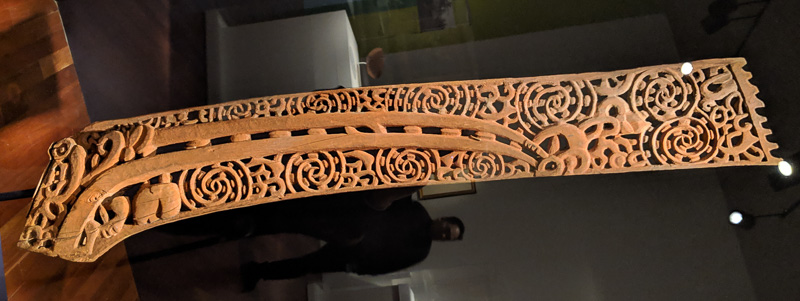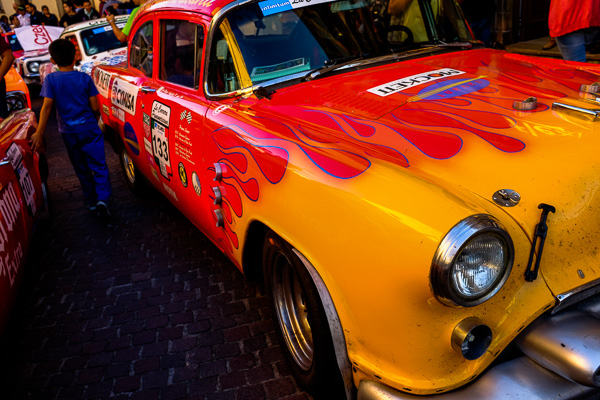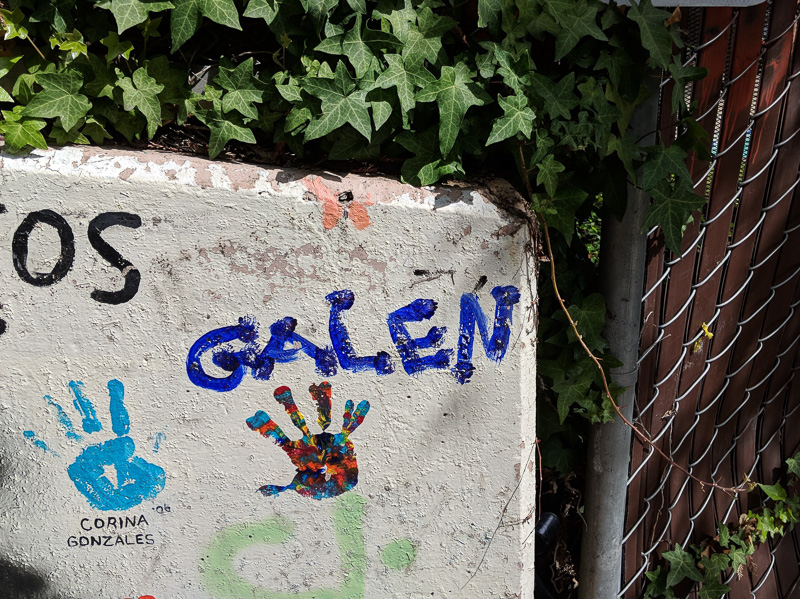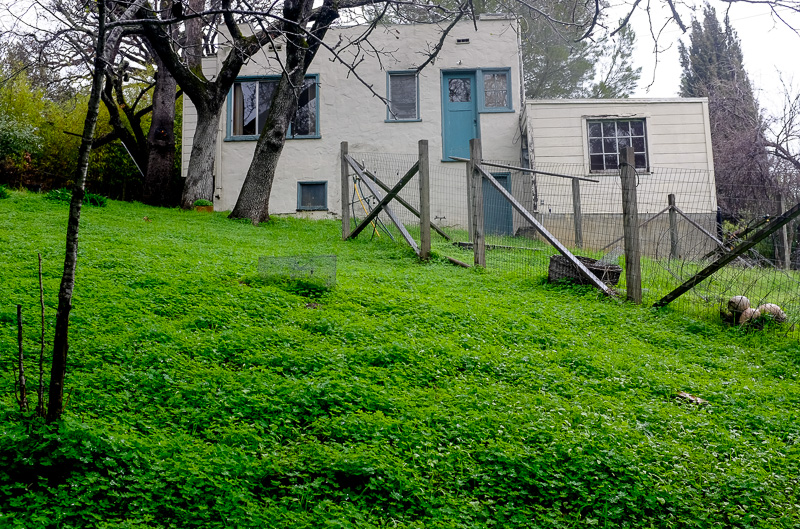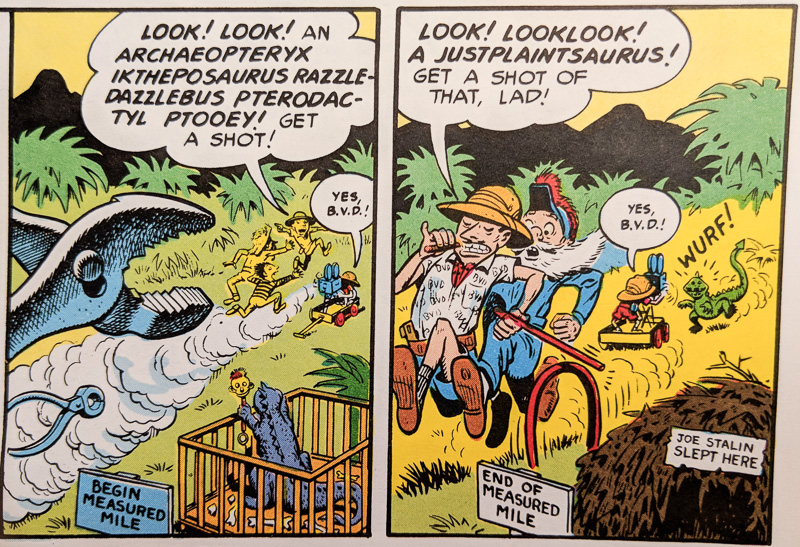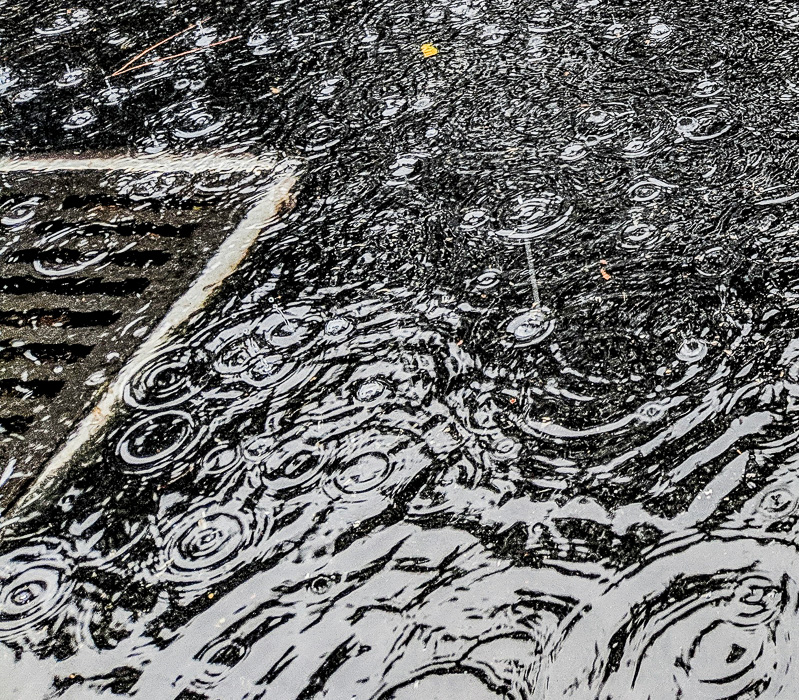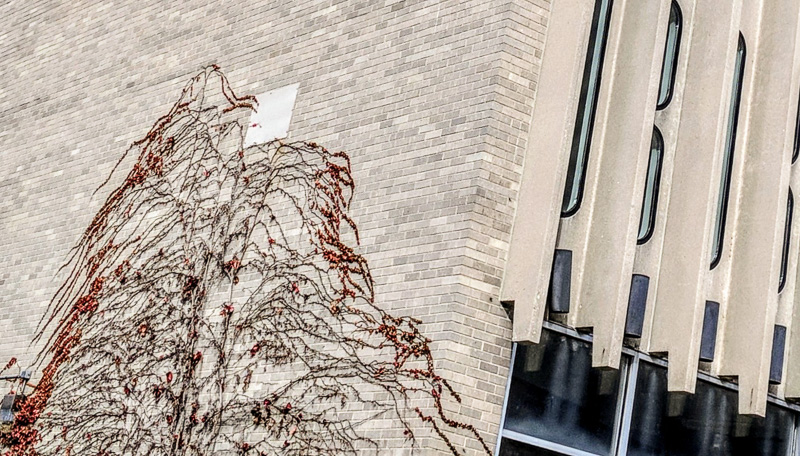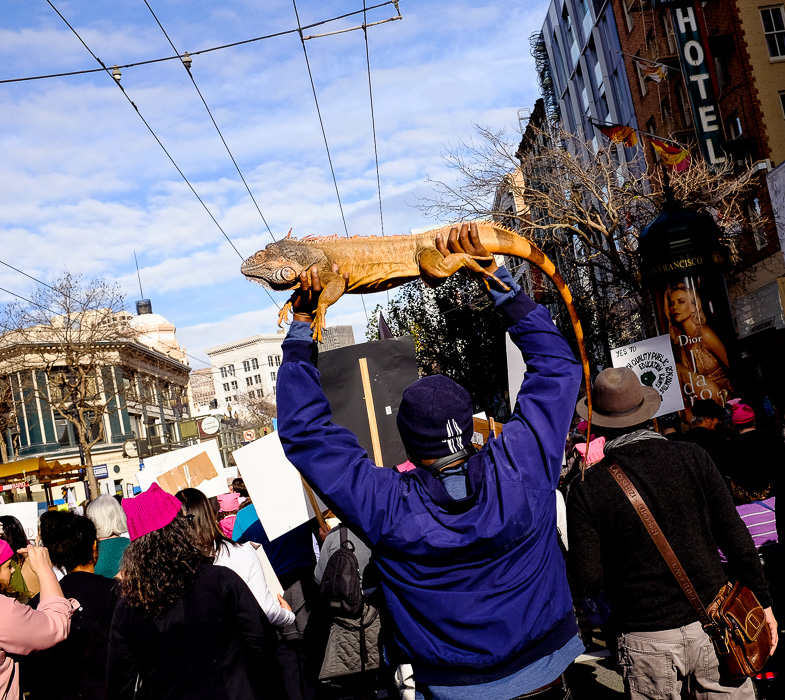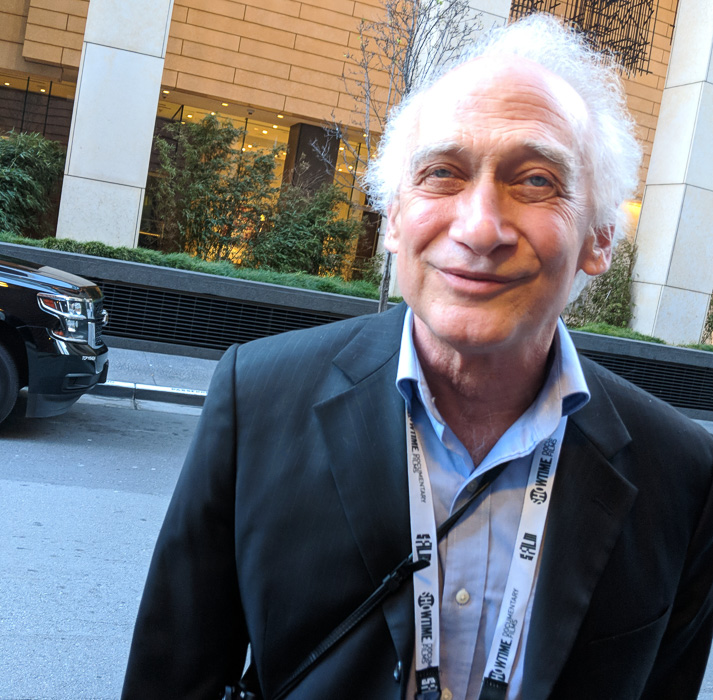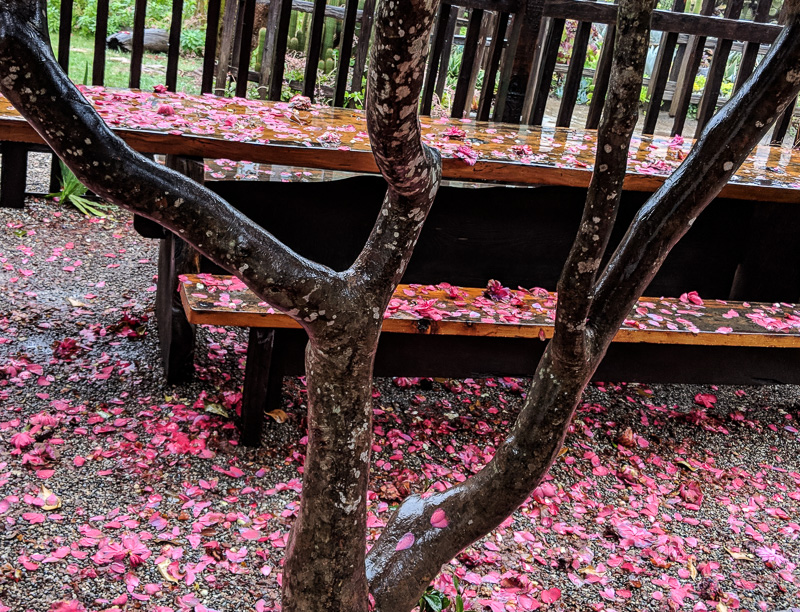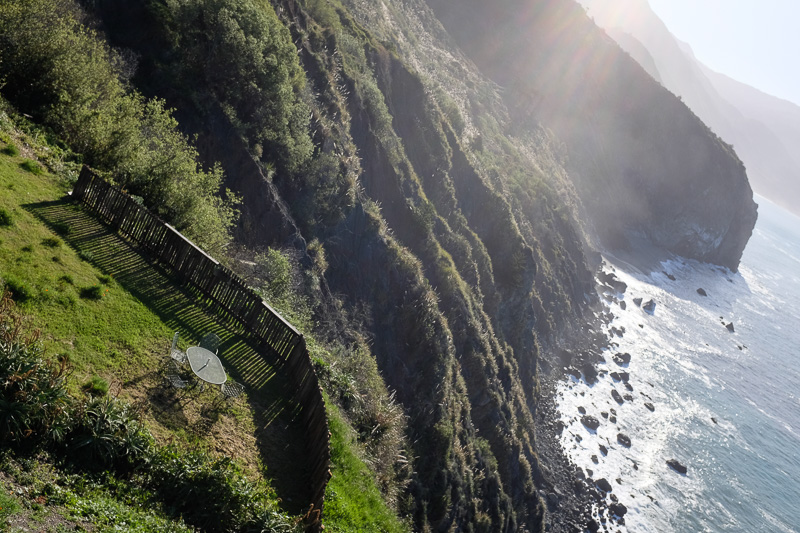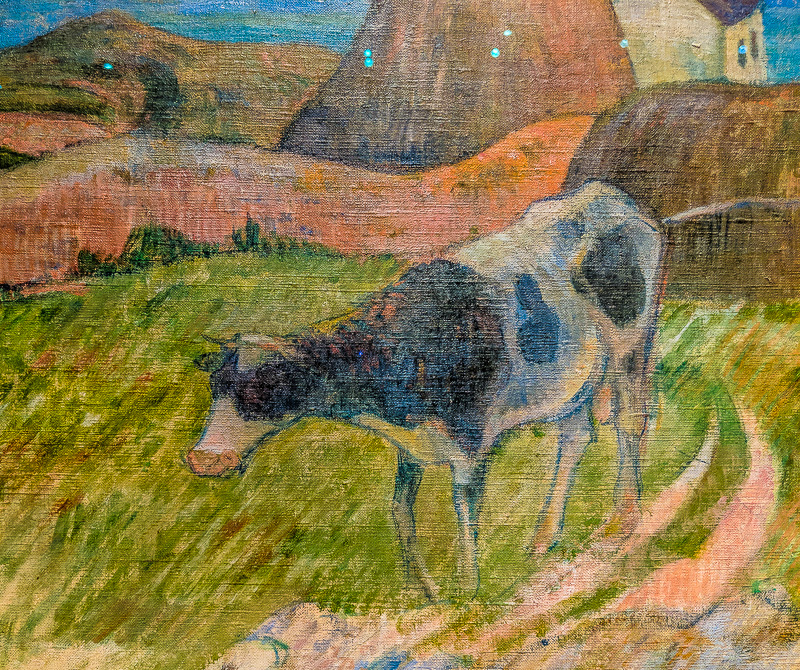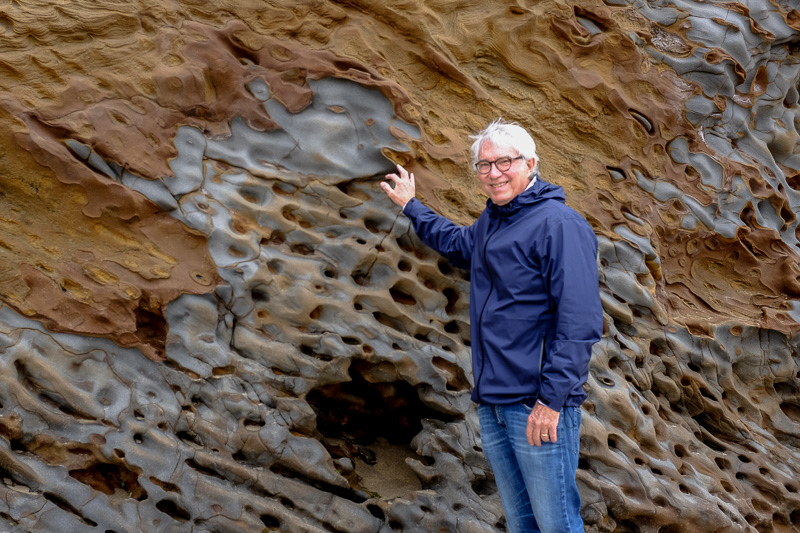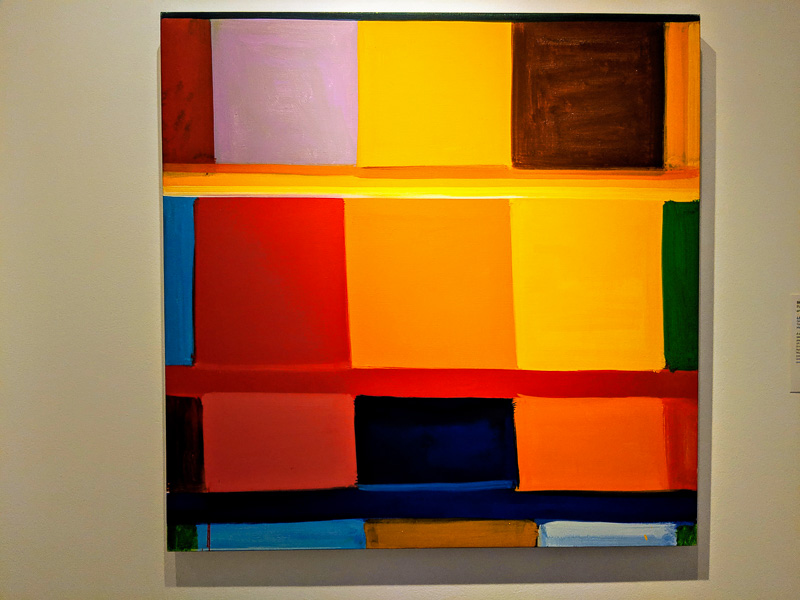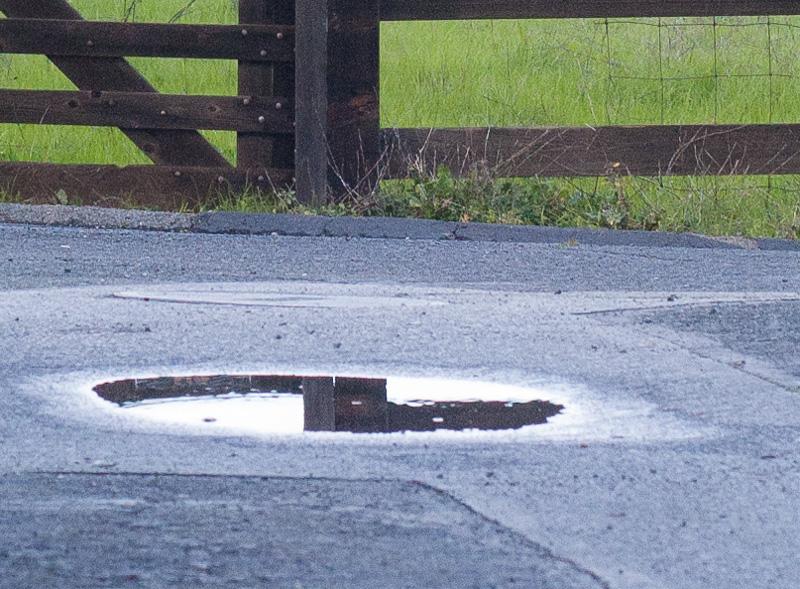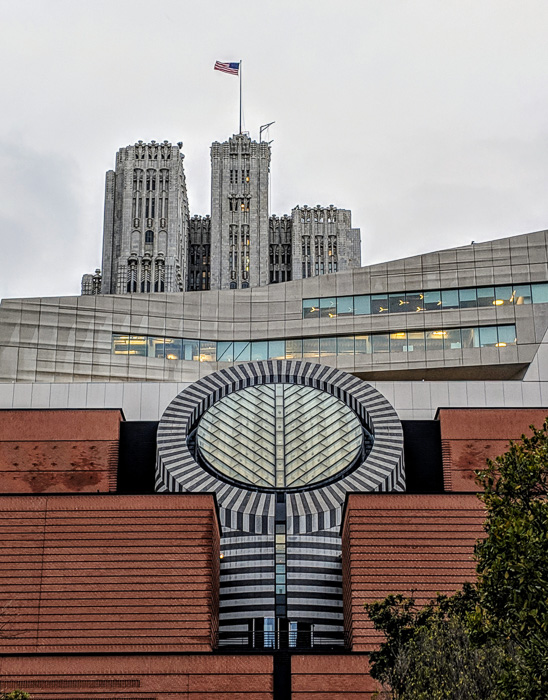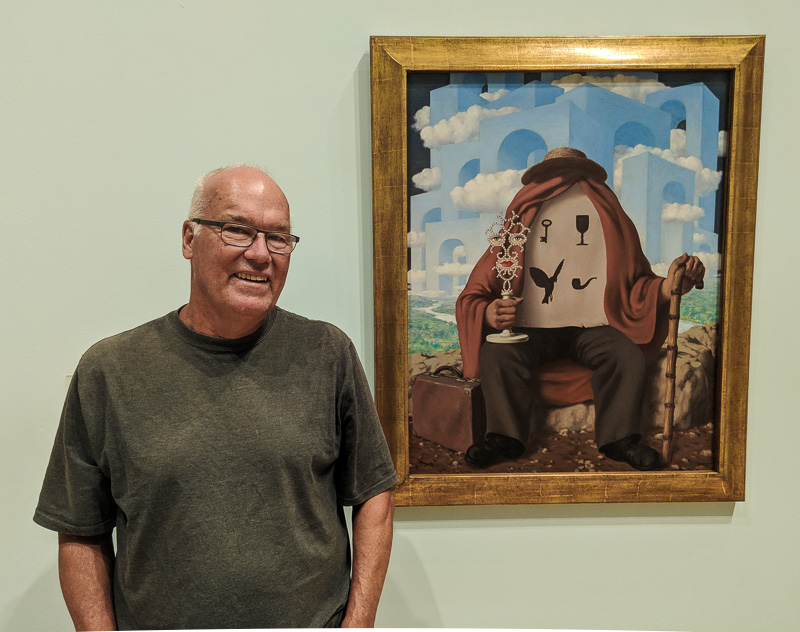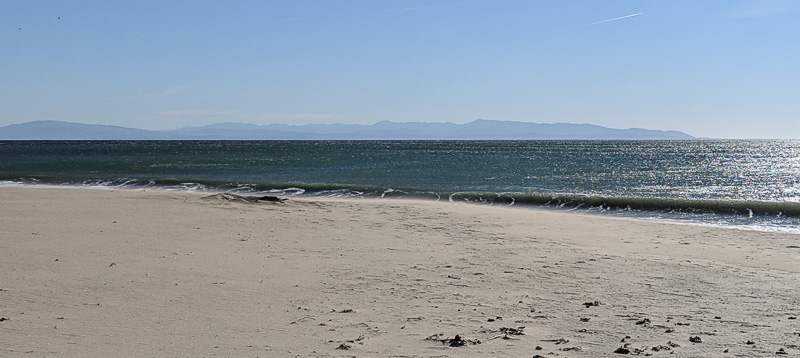This spring, with my 73rd birthday coming up, Sylvia proposed that I take her down there to celebrate, and to let her see the place for herself. So we got on a plane.
I was in Guanajuato once before, back in October, 2015. I was there for an arts conference, and I really loved the town. The colors and the unspoiled quality. Back in 2015 I blogged two posts about Guanajuato, and I still often talk about the town. Now in 2019, I’m doing two more posts, one of them today, and the second of my 2019 posts will be on May 13, 2019.
\
It was a long trip down—there was this thing about a certain kind of plane no longer being reliable, and naturally that was the kind of plane we’d booked on, so instead we had to fly this roundabout route from San Jose to Chicago to Dallas to Leon (which is the Mexican airport near Guanajuato.) As the sun set, we were finally drawing near. A peaceful moment above the clouds.

Right away, the adobe blocks of the buildings looked wonderful. And notice how there’s a pink building in there—the Mexicans are never satisfied with a block of all-beige buildings.
Guanajuato is in a ravine carved by an ancient river which has, as I understand it, moved underground. So the town has two halves, each half mounting up one of the two facing slopes. In the background of this photo, on the left, you can see this hill on the other side of the town. It’s chock full of bright little buildings like blocks. You see some hills like this in San Francisco, but not nearly so colorful
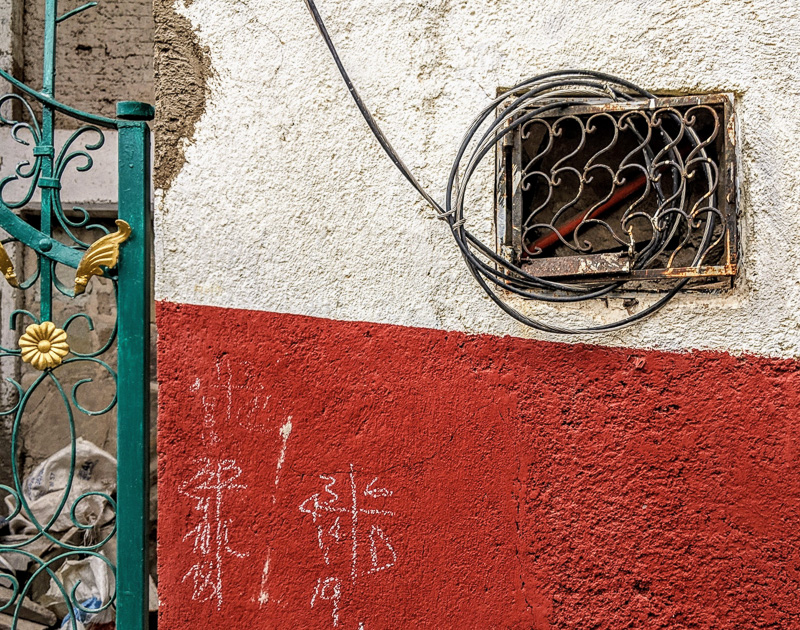
I like to walk around the streets and alleys just looking at the buildings, the people, and the walls. I think of this one as a picture of math, as the grid is kind of made of numeral 2’s, and someone scribbled a calculation, and that wire is like kind of weird arbitrary connections you find in math. Also note the irregular gray patch. And the metal flowers like prime numbers.
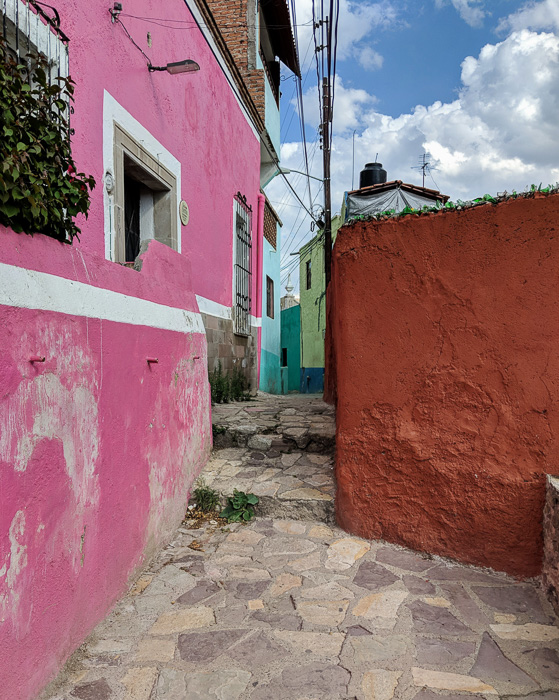
Alleys and fluffy clouds. The clouds looked firmer down here, more like they’re solid. That shade of pink…you never see that on a building in the States.
Everyone paints their house in some different wild color. Magenta, baby pink and baby blue, chartreuse, sour lime, deep cinnabar red, traffic orange, rich buttery yellow, pale citron. Often they paint “frame” rectangles around their windows.

I dig the interplay between the flat color areas and the wiggly tubes. The electrical conduits and meters are often on the outsides of the walls, which looks cool. Guanajuato goes back to the 1600s, when it was the richest silver mining town in the world. In other words, a lot of these stone and adobe houses went up before electricity was in vogue. So it was easier to put the wires on the outside. Kind of like in England, where a lot of old houses have their plumbing pipes on the outside.
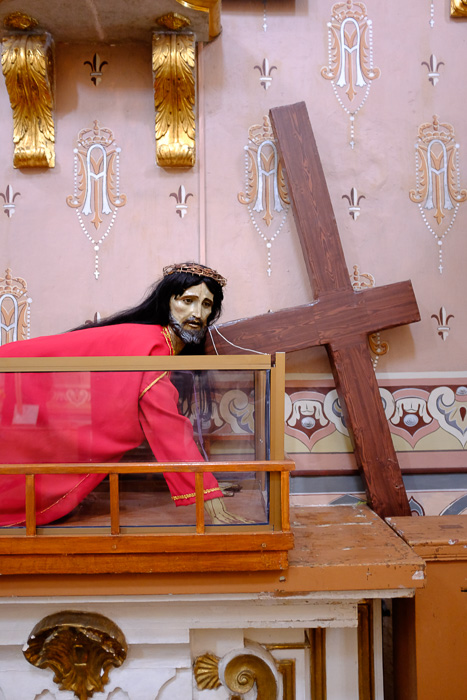
Here’s Jesus, rising out of his tomb, and rarin’ to go. Xianity is like a widespread pop mythology. I figure in Greco-Roman times, the people had a spectrum of feelings about their “gods” as broad as our feelings about Jesus. For some it’s a colorful cultural things, for others it’s a light that burns within their soul. When the art gets this literal it’s cool.
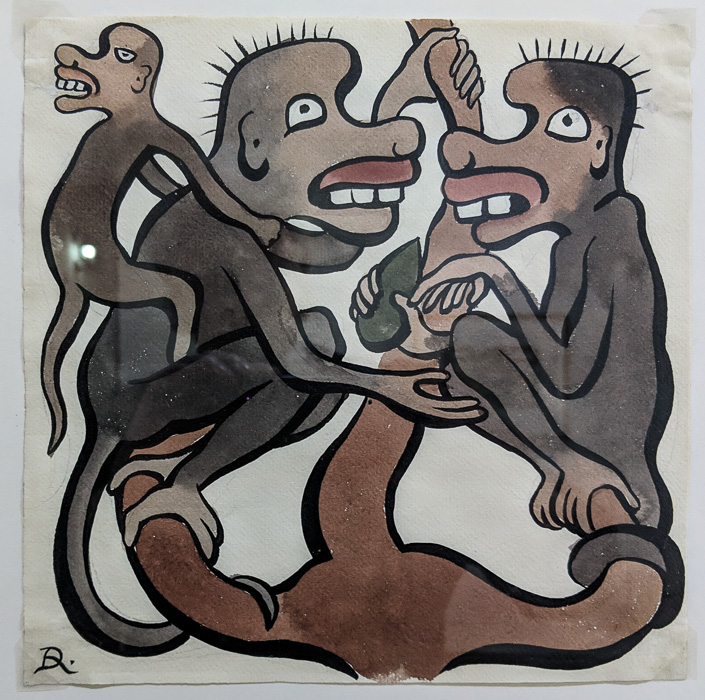
We stayed at a hotel called Meson de los Poetas, that is, House of the Poets, and two doors down was the Diego Rivera house, where our man lived until he was about six years old. His descendants had the idea of making the house into a small museum. The most fascinating art in there is a series of watercolors that Diego made for a proposed edition of a history of the Mayas called Popul Vuh. These monkeys are some earlier stage of humanity. I love the ease and wit of Diego’s lines.
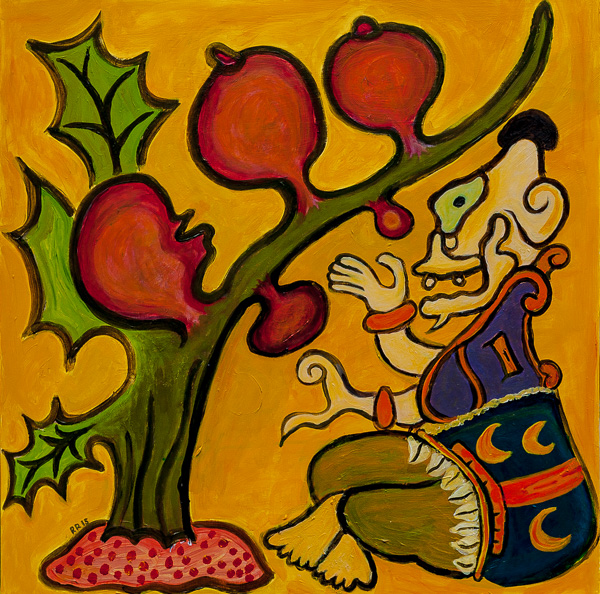
“Diego’s Hunhunahpu” acrylic on canvas, November, 2015, 36” x 36”. Click for a larger version of the painting.
After my 2015 trip to Guanajuato, I did a big painting modeled on one of Diego’s Popul Vuh watercolors that I saw. As always, more info on my Paintings page. This painting is, unaccountably (to me), still unsold.
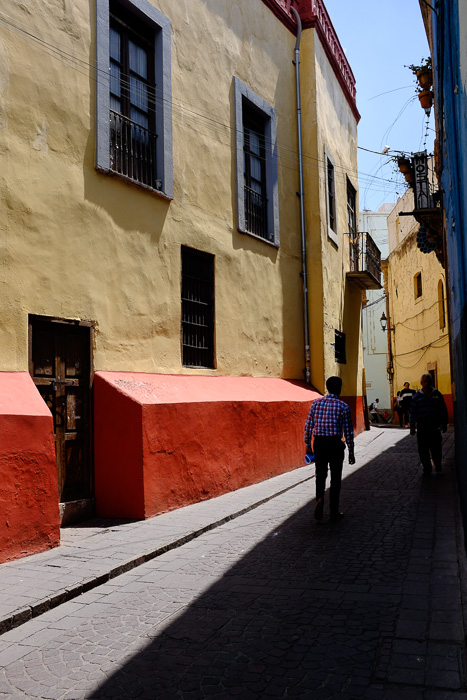
Back to 2019. Perfection on the hoof. Those dusky deep red buttresses, and the rich buttery yellow of the wall. The war, low morning sun.
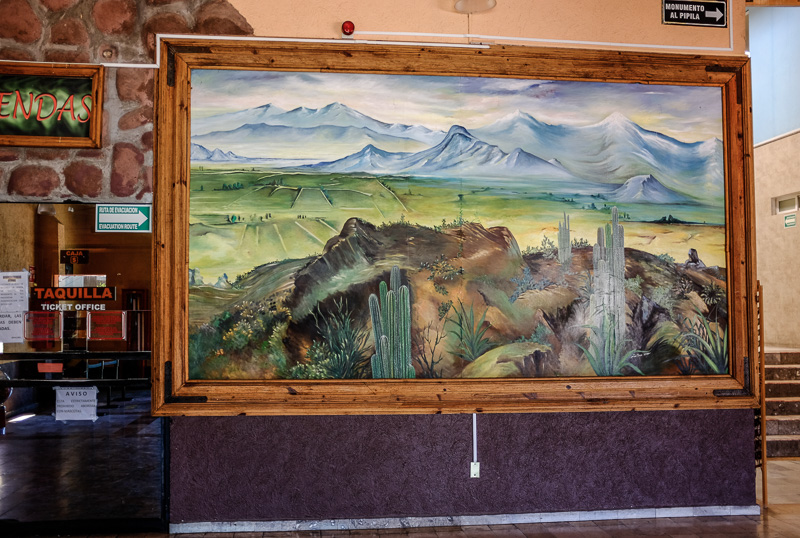
Guanajuato has a tiny cog-railway that runs up one of the ravine-city’s two sides. The car arrives in a tidy marble mall, fairly empty on a week day, with silver shops. I liked this big painting they had on display up there.

Speaking of art, here’s a cool original painting that was in our bedroom. Something about the culture or economics of Mexico makes it reasonable for a small hotel to have real paintings in the room instead of reproductions. This one is called, Maria Loreto de la Sangre de Christo, by G. G. Quevedo. I like that name Quevedo, it appears in a story by Jorge Luis Borges.
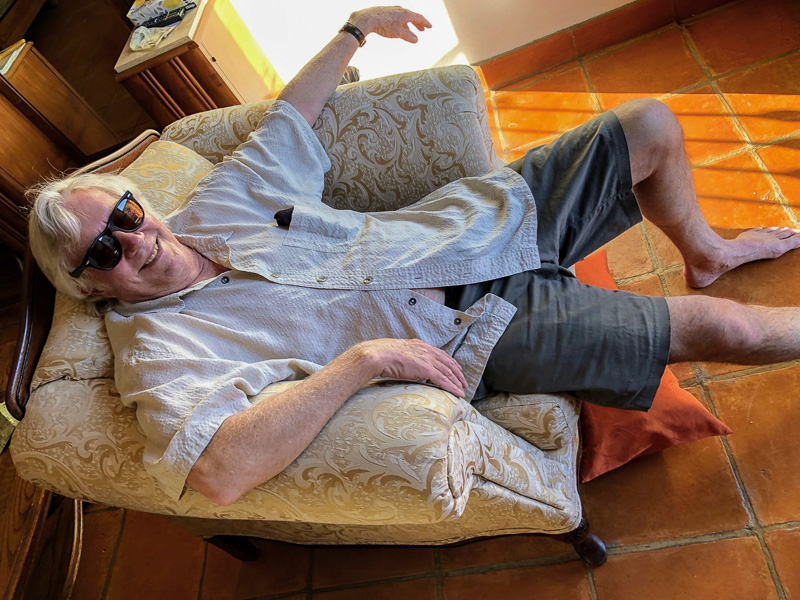
Deep idleness and relaxation in our room in the afternoons. That magical word: Siesta! Supper only starts at 8 pm, you’ve walked all morning, had a lunch at 2 pm, and then…kickback time. Sitting cross-legged resting the muscles of my legs. Or lounging in one of our comfortable chairs.
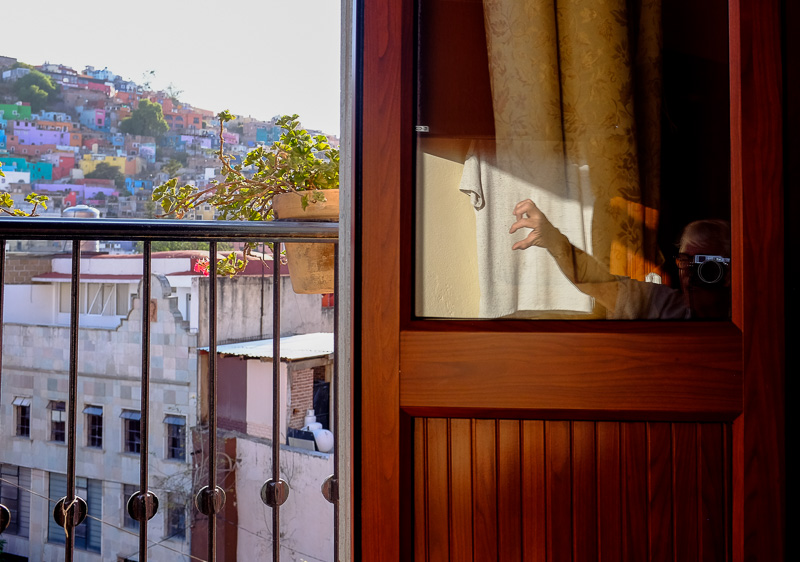
Not reading, not computing, looking out the window, enjoying the sight of that hill of houses, and, eventually, playing with my camera.
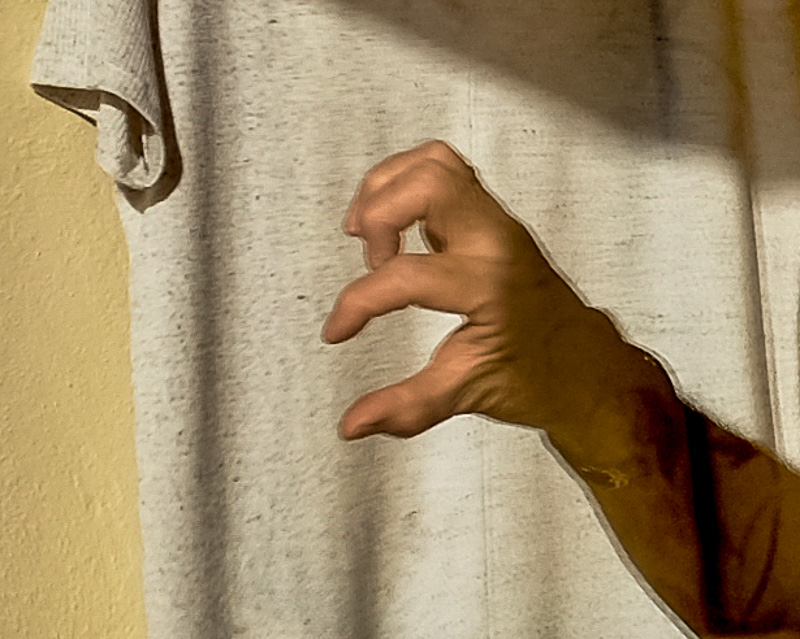
I spent over half an hour perfecting a duck hand, or maybe it’s a dinosaur, one of those guys with a knob on top of his head. The double edges due to mirroring, as I’m photographing the image in the door’s glass. How odd and alien and protean our human bodies are.

The Conquistador coffee roaster lay just under our hotel, cached in a space the size of a narrow living-room, with the machine roasting beans, off and on, all day, and clouds of bean-steam lufting out in foggy veils, causing, early in the day, the tidily uniformed school girls to feign great coughing fits. I’d sit there on a stool having a mocha mix of their coffee and chocolate. Peace.
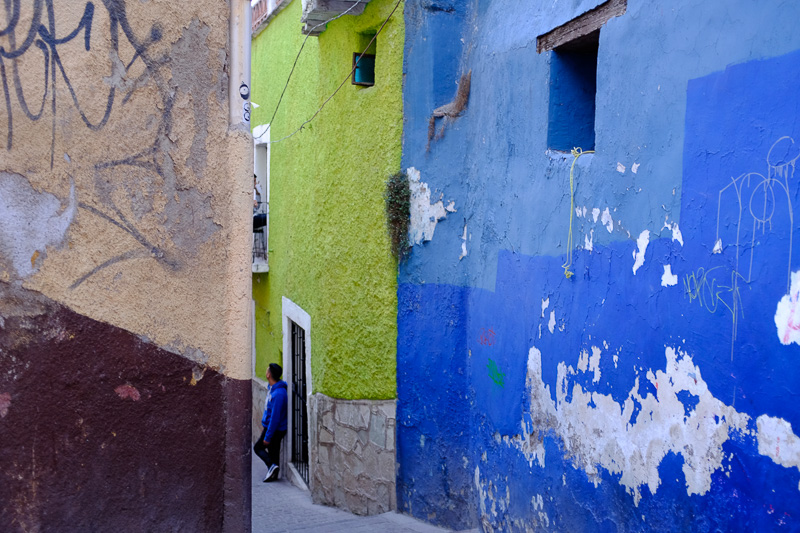
Peeling spots of the alley walls only add to their appeal. Rich visual chaos, with its own implicit order. God is everywhere.

Click for a larger version of this image.
A night panorama of our view, sewn together from three full-size frames.
I remembered this view really well from my visit in 2015—I managed to get the same room as before, a salmon returning to his hatchery, savoring the aethereal memory scent.
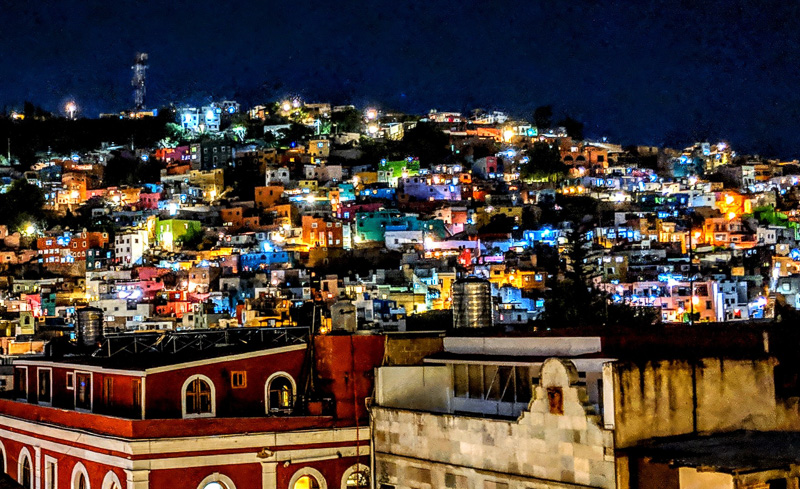
With the ultra-low-light “Night Sight” setting on my Pixel phone the view looked like this. Those aren’t colored lights on the houses—the lights are white or yellow, the colors are from the walls.

In a lane near us we found a little art shop, selling etchings and postcards by a man and woman who ran a workshop together. The sales woman was pleasant, an local artist herself. speaking a good English (not a given at all). “Mexicans really like skulls,” I remarked, just to be saying something. “We love our death culture,” she said.
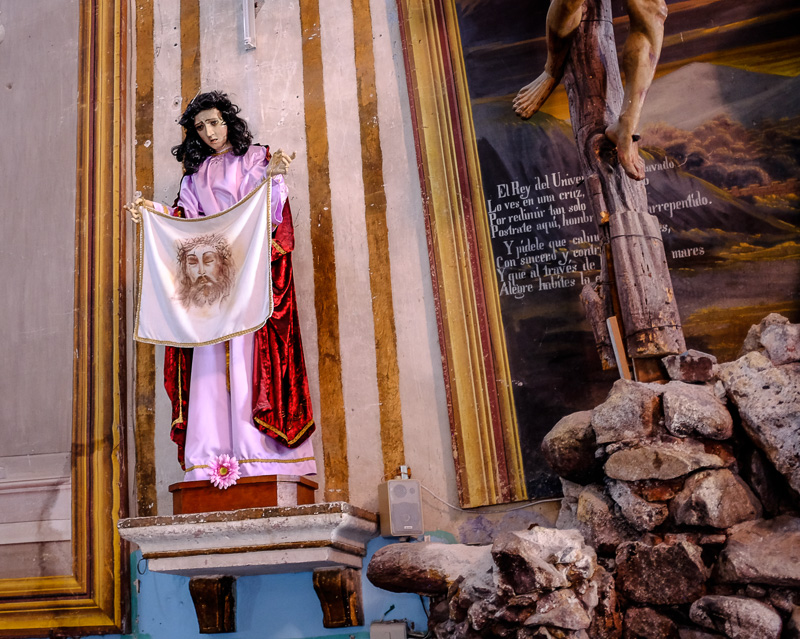
Here’s Veronica with her veil with Our Lord’s face on it. All sorts of art in the churches, not limited to any one style. Did Betty get a veil too? Whose face would be on it?
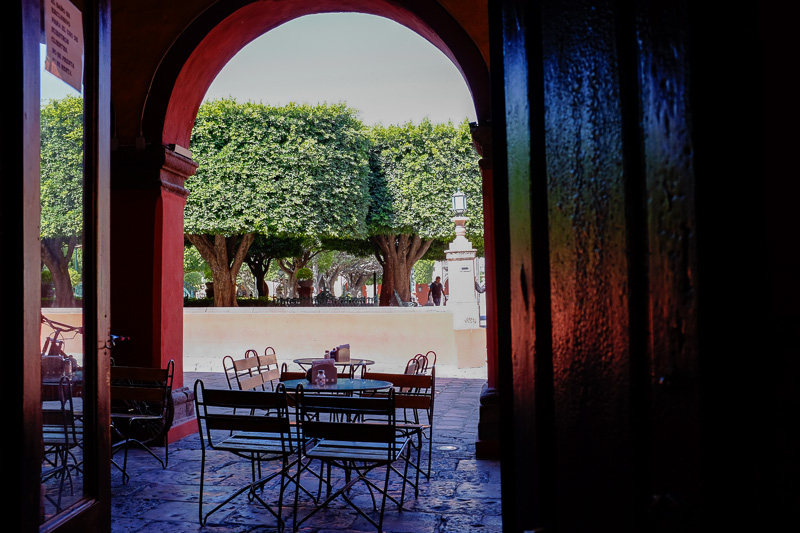
At one point we took a bus from Guanajuato over to the town of San Miguel de Allende for the day. San Miguel is better known, and we wanted to have a look. In many ways it’s as beautiful a town as Guanajuato, but it doesn’t have Guanajuato’s pristine, unspoiled quality.
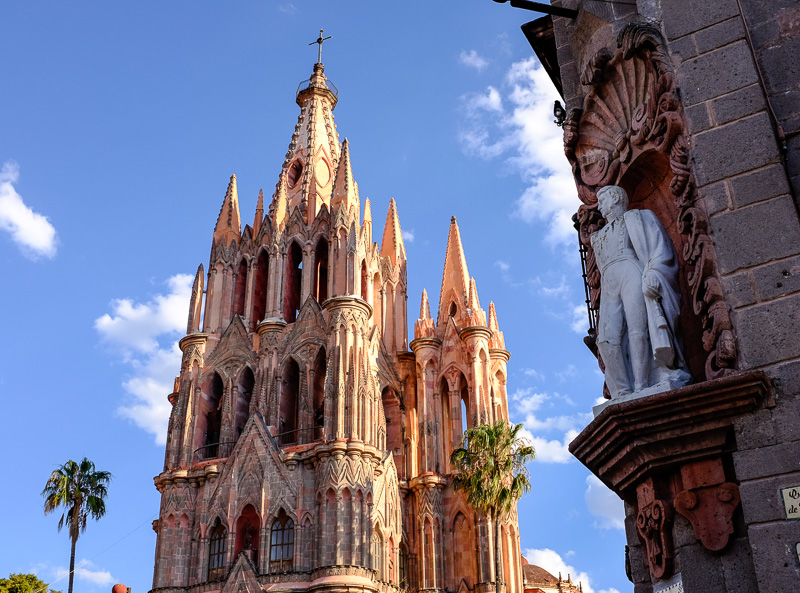
San Miguel is known for the spire of its cathedral. The man who designed and built the church had only seen photos of Gothic cathedrals, so he made it up as he went along, and the result is wonderful.

Dig the line of yuccas. Very cool. Like a travel poster almost.
A downside of San Miguel is that something like ten percent of the people who live there are white US retirees, who have the look of Mill Valley people, although some are in fact from the East Coast. Of course Mexico City is fully cosmopolitan, but I think that’s a different thing.
At times I’ve wondered if it would be fun to go retire in San Miguel, but it’s maybe not a vibe that would work for me. I fear an entitled, self-satisfied, high-school-clannishness thing. Me thinking as a perennial outsider in saying that. But possibly if I ever did move there I’d soon fit in.
But there’s also the matter of the wealth-gap between the retirees and the locals. Seems like that could make you uncomfortable.

I really liked this guy selling hats. So classic. Loads of day-tripping white tourists thronged the San Miguel streets.
From a total outsider perspective, the locals in Guanajuato seemed at little more at ease than in San Miguel. Doing their thing in their own town. Fully in control.
I never once heard anyone mention Trump on this trip. For a lot of the local’s, he’s not even on their radar. Like, do I know the name of the President of Mexico? Parallel worlds.
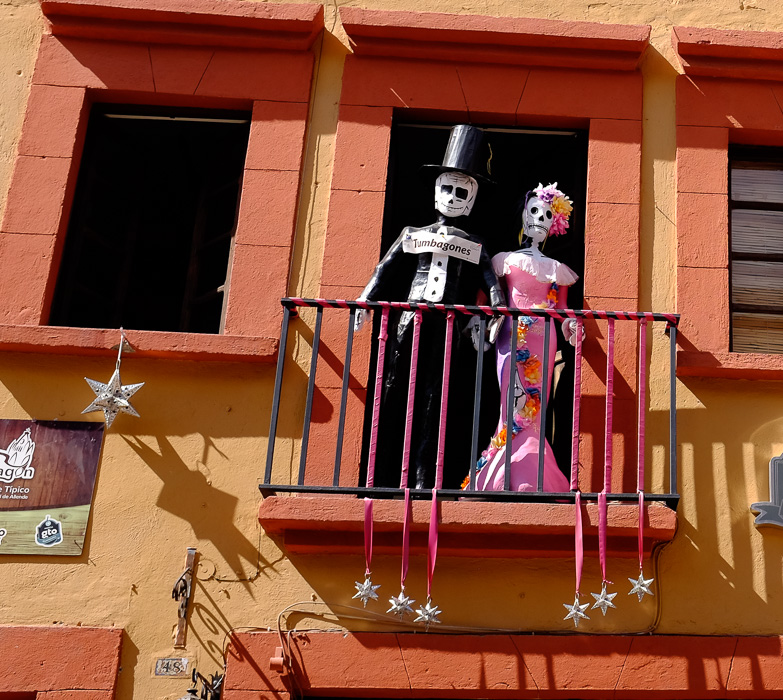
San Miguel has scads of hip eateries and native art shops, also some higher end galleries. I liked seeing Mr. and Mrs. Death here above a restaurant.

I walked around San Miguel alone for an hour in the late afternoon, in that “golden hour” of sun, going nuts with the colors and the shadows, enjoying my trusty Fujifilm X100T digital camera with its fixed 23 mm lens. Well, not totally trusty, as it has a lot of manual settings, and it’s easy for me to mess them up, even now, after using it for over four years.
I always rework my photos in Adobe LightRoom…it’s almost like the shots I take are negatives and then I “develop” them on my computer. With a wider angle lens like I have, it’s often a matter of cropping down to the part you want.

Nice visual rhyme of the triangles here.
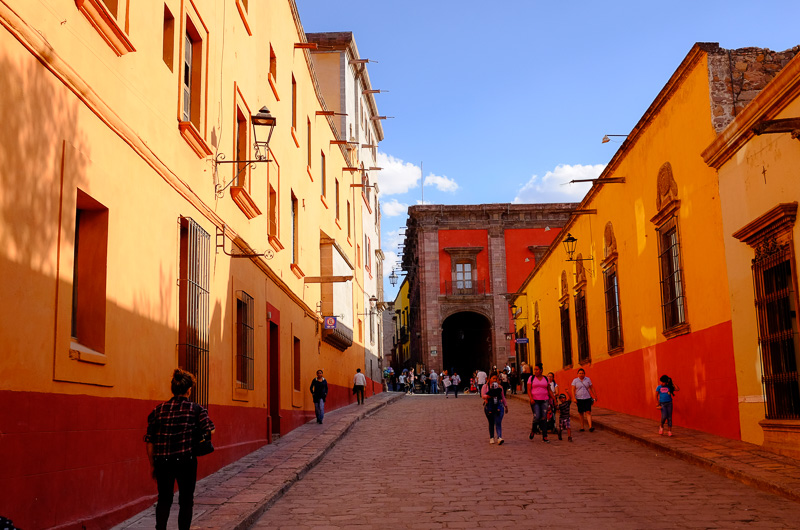
I was just feasting on those warm yellows and reds and ochers. Showdown at dusk. The San Miguel streets are a little wider and straighter than in Guanajuato. Although, as I say, more replete with rubber-necking goobs like me…though not really that many of us, not everywhere.
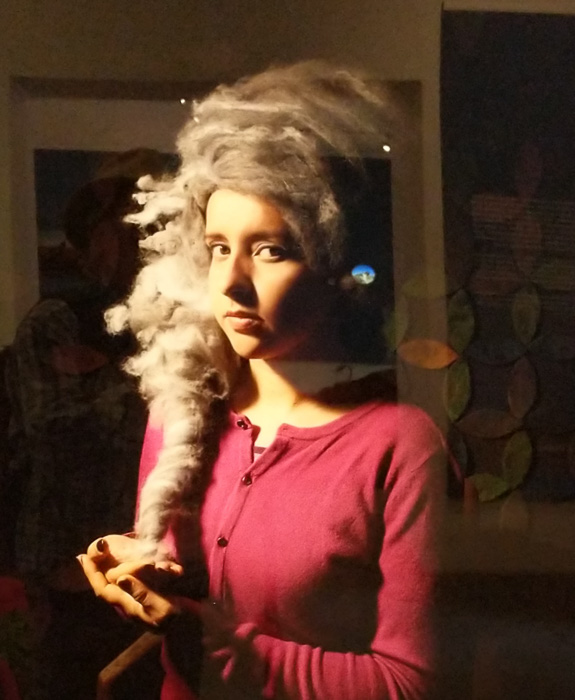
We wandered into an art show in a large building…had to pass in between a pair of guards…I thought maybe they’d want money or a search or something, but not at all. It felt like the locals weren’t much into hassling strangers over tiny things.
Anyway, this cool US artist Daniela Edburg, she was into was twisting up skeins of wool into shapes like tornadoes…and then taking photos of them. In one photo she held the faux-twister as if it were on a Kansas-type horizon. And here she lets it merge with her hair (I assume that’s her in the photo). “I am a tornado.” Yes. One Halloween our daughter Georgia “dressed as a tornado.” I don’t remember the details of the outfit, but I love the concept. It’s very Georgia.
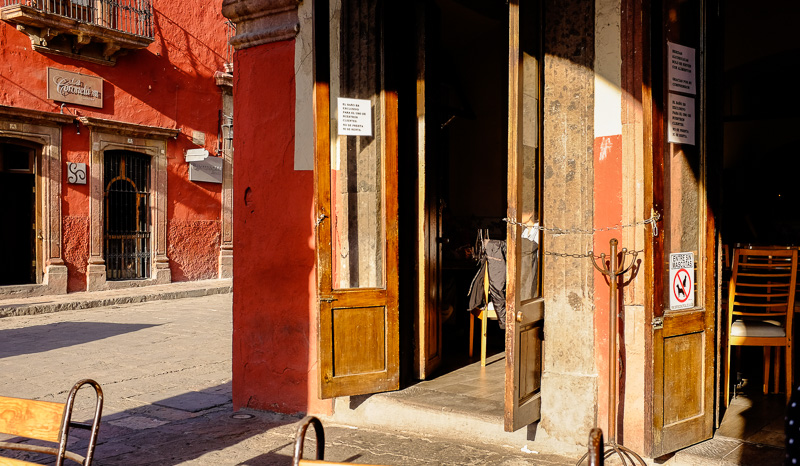
I just love this photo. So Old Mexico. Like from Sam Peckinpah or from Brando’s One-Eyed Jacks. The late afternoon light, yes. Not a soul in sight. The warm stucco. Perfection. It’s a cafe on the main square next to the cathedral. And for spots like this, you gotta hand it to San Miguel.
Notice that little stand with three or four knobs? That’s a portable hat rack. If you like, you have one next to your table, and put your hats on it! I wore a hat most of the time we were down there, an old white felt model.
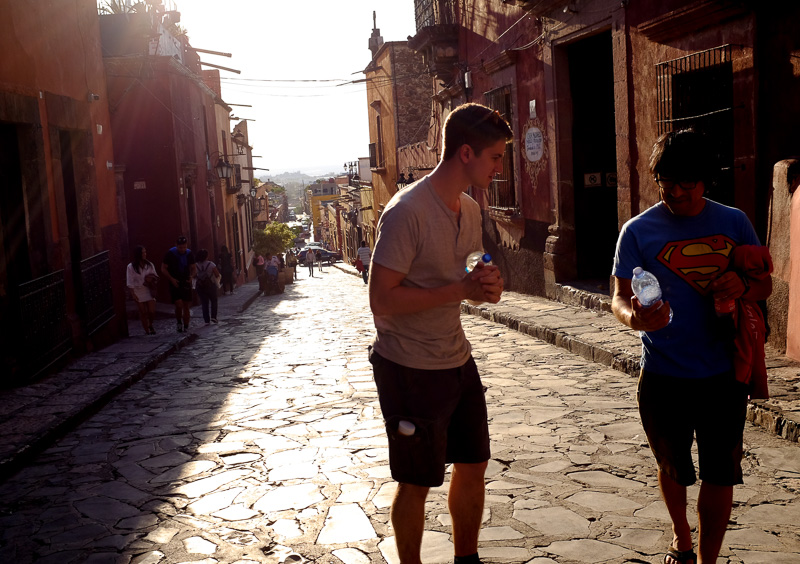
At the end of our day in San Miguel we got a taxi down to the bus terminal. I like these dudes in silhouette. Dark with light.
The bus we road on was a “first class” line of buses, with really a lot of leg room, amazingly nice, I’ve never seen a bus that comfortable in the US. Not that it was expensive. Maybe $7 for the hour-and-a-half ride between the two towns, basically busing through scrubby high desert. We were at 6,000 feet the whole time.
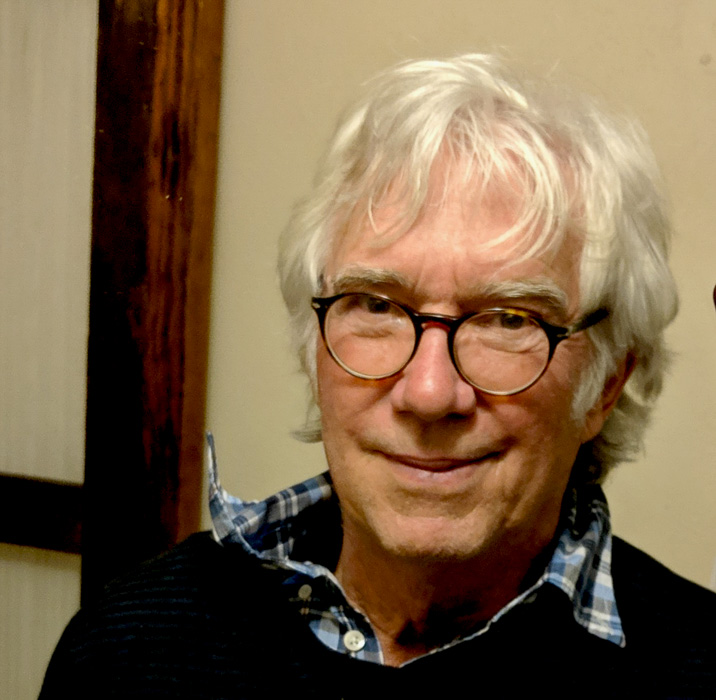
When we got back to our Meson de Los Poetas room after the San Miguel outing, I took a selfie of myself, looking hale and lucid, and the next morning, March 22, 2019, I posted it on FB and Twitter with the announcement that it was my 73rd birthday, thereby indirectly petitioning for b-day cheer. Big score. I got hundreds of likes and replies, and on my birthday it was a soothing, pleasant activity to scroll through the replies, “liking” them, enjoying what they said.
As I mentioned at the start, I’ll put up the second of my 2019 posts on Guanajuato on May 13, 2019.
…
